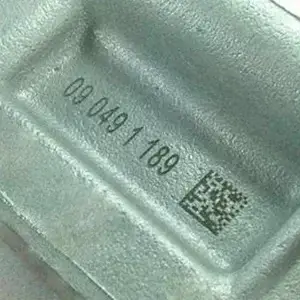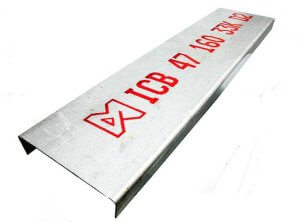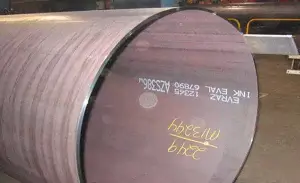Marking Technology 101: When and how to put the pedal to the metal
Metal marking and coding has a long history. The first documented use of hallmarks – coded marks made on precious metals to certify their content or provenance – dates back to silver bars from around 350 AD. Ever since those early days, metal marking has served as a form of identification and consumer protection for the buyers and owners of precious metal items.
Today’s metals are far more varied than the gold, silver and platinum known for their ancient hallmarks, but the underlying purpose of metal coding and marking remains much the same. The key to marking success in the metals industry is understanding why marking must be done and how to do it most effectively.
Here’s a basic overview of metal coding and marking and some key questions to ask yourself before you invest in a new or upgraded marking system.
How is metal marking used?
There are four main reasons industrial manufacturers put marks on metals and metal products:
- Primary identification
- Traceability
- Compliance
- Operational
Primary Identification
Metal manufacturers use marks to convey basic information about the product, including the company name and/or brand trademark, part numbers, sizes and other descriptors.
Traceability
Much like the hallmarks of ancient times that established content and provenance, today’s industrial marks provide deeper product information that goes beyond simple identification – including serial numbers, time & date stamps, batch codes, bar codes and other marks that enable manufacturers, suppliers and customers to trace the origin of the products and materials.

Today, traceability is an essential component, not only for inventory management, but also in cases of product recalls, where knowing the exact origin of a metal product enables faster more efficient investigation and recall from retailers and customers. When placing barcodes on products, it’s hard to overstate the importance of accuracy and barcode validation during the marking process.
Compliance
In addition to bar codes for inventory tracking, marks on metal can also convey information required by governments, industry associations and/or vendor specifications to ensure compliance with environmental regulations, taxation, country of origin or other regulatory processes.
A recent example where this type of marking requirement may come into play stems from the U.S. government’s initiatives to develop more domestic supply chains for EVs, including mining for critical minerals and manufacturing for lithium-ion batteries and semiconductor chips.
Operational
There are also internal and process-oriented reasons for metal marking, including orientation or location marks that facilitate a metal product moving through the production line, inspection marking (e.g. defect marking or certifying that a product has passed inspection), color coding, instructional information (e.g. arrows) and 2D bar codes that support automation processes.
Basic methods of marking for metals
Both ancient and modern hallmarks used the oldest form of marking – indenting. By stamp-indenting, etching or engraving on a surface, the metal is displaced in the form desired for the mark. This form of marking is very durable and is often used in the tool and automotive industries or for engraving on finished products like jewelry or fine silverware.
Labeling and tagging – that is attaching a label to the metal product – is also sometimes used with metals, particularly for retail and consumer-facing purposes, and is an adjunct to messages printed directly on the metal products.
By far, however, printing is the most often used method for metal marking and coding on sheet metal, pipes, tubes, coils, slabs and other metal surfaces because it offers the greatest combination of flexibility, precision and cost-effectiveness. There are many forms of printed messages used on metals, depending on the nature of production processes and requirements. The two most common forms are contact printing and inkjet printing.
Contact Printing
Direct contact printing with ink is sometimes done on sheet metal and is most often used when color or high contrast are required. In contact printing, the characters or type wheel come in direct contact with the surface of the metal. While contact printing may be useful when the same mark will be used consistently with few, if any, changes on the production line, the process also tends to be messier, and because parts come into direct contact with metal, the equipment wears faster and requires frequent maintenance. It is also very inflexible, requiring pre-made dies before new messages can be created and applied.
Inkjet Printing

Inkjet printing is the most common way of marking metals due to its high degree of flexibility and reliability as well as its lower cost overall. Inkjet printing provides durable, high-quality printing of text, logos, UPCs, 1D and 2D barcodes and other required marks. It is fast and easily adaptable to uneven surfaces, enabling accurate, high-speed marking on a wide variety of metal shapes and textures.
Because it can be controlled digitally by an easy-to-use central controller, inkjet printing enables fast message changeover for marking different products on the same line. There are different inkjet printing technologies available to suit a variety of metal marking needs. By far the most used are the robust and versatile drop-on-demand (DOD) valve-jet and thermal inkjet (TIJ) technologies. DOD, in particular, stands out for it outstanding reliability and ability to withstand dust and other environmental challenges.
For metal marking, inks must meet some unique requirements
Ink choices differ based on the application and use of the metal, and harsh conditions in metal industries, including high temperatures, oily and dusty surfaces and changing material compositions, create some unique challenges and requirements for inks. For example, some messages must be permanent, requiring inks that are durable against the elements. Other uses require marks that are removable, for example when internal tracking codes used for production need to be removed for aesthetic reasons or replaced with a different mark for a different stage of production. Some inks are only visible under UV light, making them useful for internal codes that don’t need to be visible in the finished product or for tracking codes on finished goods for traceability and counterfeit detection. Inks may have specific formulations to meet compliance requirements, like aerospace-approved or halogen-free.
Manufacturing conditions and requirements also drive the selection of ink types. Extra high-contrast inks, such as white pigmented ink, are often used for marking on dark metals. There are specialty inks, like MEK and acetone-based inks, that can penetrate through oils, lubricants, coatings and mill scale. Some types of metal production require very adhesive and fast-drying ink formulations to avoid smearing. And often inks must be heat-resistant in order to mark on hot metal and/or for the marks themselves to stand up to high temperature exposures. It’s worth noting that Matthews Marking Systems has a wide variety of ink types for marking metal and can create custom ink formulations to meet virtually any requirement.
Specialized or customized equipment may be needed for metal marking
Because metals come in so many form factors, from pipes to sheet metal, marking often requires considerable versatility in equipment.
For example, strip steel tends to move very fast in production, and print heads need to keep up. Fast-moving steel can easily cause damage, so depending on your line, it may be important to have kick brackets that can snap out of the way if there is a danger of the head being hit. And if your production line is hot, printhead cooling may be required.

You may need the ability to raise and lower print heads to suit varying thicknesses of steel or to have an extended throw distance (distance between the print head and the metal being marked). Or you may need a traversing system that can move print heads into large pipes for marking on the interior, to recenter marks on strips of metal or to move heads offline.
To maintain production efficiency, the marking system should be easy to use so that the messages you’re printing can be easily changed to accommodate customer requirements or to help improve internal tracking and inventory management. Similarly, the printing equipment should be highly durable, require low to zero maintenance and be able to operate under both extreme hot and cold conditions like those often found in plants, which typically are not temperature controlled.
For most applications, you’ll also want to look for print technology that can generate big bold marks that can stand up to repeated handling without rubbing off. Environmental factors can also be a consideration if the print system isn’t fully self-contained, allowing unwanted emissions from some ink formulations. The printer should also start up quickly, so production isn’t being held up waiting for the marking system to warm up.
For these reasons, continuous inkjet (CIJ) technology, widely used in the consumer-packaged goods (CPG) industry, is poorly suited for metal marking applications. CIJ technology is limited in terms of character size, requires a 10-15 min. startup time, and exposes ink to the environment. Further, CIJ printers struggle to maintain quality under extreme temperatures.
Print controllers make metal marking more efficient and adaptable
No matter what your special needs, industrial metal production coding and marking requires a print controller. Ideally, your controller such as our MPERIA platform, will accommodate multiple printers and include integration software that makes it easy for workers to change or adjust messages quickly. It must also be robust enough to withstand the harsh conditions in a metal manufacturing plant environment.
Determine your metal marking requirements
Before you invest in new or upgraded technology for your metal marking, you’ll need to know the answers to some key questions. To that end, we’ve compiled a handy checklist.
Knowing your current processes – and potential future needs – is essential. If you’re new to marking and aren’t sure how to answer the questions on the checklist, it may be the right time to seek advice from experts in the field of product coding and marking.
Matthews has been in the metal marking business since 1850, when John D. Matthews engraved his first iron die. Since then, we’ve continued a rich tradition of offering metal marking machines and solutions of unmatched versatility and quality. We’re here to answer any questions you might have and help you find solutions that meet your specific metal marking and coding needs. Just fill out the easy form below and we’ll get you set up for a free consultation, including sample marks on your metals.
